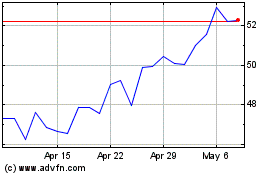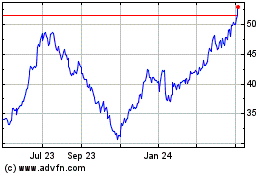By Sharon Terlep
Clorox Co., Amazon.com Inc. and Domino's Pizza Inc. can't ramp
up fast enough to meet demand for cleaning products, home
deliveries and snack food. More people are streaming videos from
Netflix and music from Spotify. Shares of Peloton Interactive Inc.
have soared as fitness buffs scrap their gym memberships.
Meanwhile companies that rely on people traveling, being
together or venturing out in public are crashing. Restaurant chain
Cheesecake Factory Inc. furloughed most of its workers. Air carrier
Delta Air Lines Inc. and retailer J.Crew Group Inc. are slashing
costs, scrambling for loans and restructuring as they sustain
massive losses.
The big question is how many of these new consumer habits will
endure more permanently as the country inches back to something
resembling normal life. The answer will have far-reaching
implications for industries from food and fashion to travel and
technology, forcing companies to rework supply chains, product
lineups and relationships with retailers.
"The three month period we are going through is going to equate
to three years of consumer changes wrapped up in one quarter,"
David Gibbs, chief executive officer of Taco Bell parent Yum Brands
Inc., said this week.
Not everyone agrees. Several retailers said spending slowed in
April after consumers stockpiled in March. "We largely expect
consumers to eventually return to previous habits, as they slowly
exit confinement and cautiously settle into a new normal," PepsiCo
Inc. CEO Ramon Laguarta said.
Take the Longos, a couple that lives in Valhalla, N.Y., a small
town 30 miles north of Manhattan. Pamela Longo, an assistant
principal and mother of two, wasn't a fan of home workouts. Her
husband, Michael, who owns a financial planning firm, long wanted
to work once a week from home but always ended up in the
office.
Seven weeks after they were forced into their suburban New York
home by coronavirus, Pamela has started riding a Peloton bike in
the basement that allows users to join in virtual spin classes. She
also added online workout classes, finding the fitness combination
far more efficient and motivational than she anticipated, she
said.
"I never would have predicted this," she said.
Michael has discovered he has more family time without a
twice-daily, 30-minute commute, he is hashing out plans to spend as
little as three days a week at the office. "This is a horrible
thing that has happened, but there is some good coming out of
this," Mr. Longo said.
Some of their changes may be more temporary. For instance,
Pamela says she has enjoyed learning new, time-consuming recipes,
including an Italian pasta dish on a recent night, but will revert
to simpler dishes once she returns to work.
To get inside the minds of consumers like the Longos,
corporations are marshaling their expertise and resources in hopes
of getting ahead of changing needs and preferences.
Consumer-products giant Procter & Gamble Co., for example,
knows that people aren't only buying more Tide laundry detergent
but also doing more loads of laundry because it follows digital
monitors installed inside some consumers' washing machines to show
how often they run loads. Legions of analysts and consultants are
taking surveys, combing sales data and building models to try to
gauge where demand is going.
More subtle, micro trends are emerging as well. Retailers report
selling a higher ratio of shirts to pants, as people dress for
video calls. Jigsaw puzzles are selling out. Post-It notes are
falling out of favor amid empty offices. Pricey coffee is getting a
boost, as cafe-lovers are forced to brew at home.
"A lot of people are focused on what the 80% of consumers will
feel like in the new normal. Are they going to go out and eat, or
go to the movie?, " said David Garfield, managing director of
consulting firm AlixPartners and the head of the consumer-products
practice. "It's really about the remaining 20%. Because most
businesses can't operate on 80% of demand. They will need a major
overhaul."
More evidence of how consumers are behaving emerged last week in
a series of earnings reports. The pandemic is driving up demand for
packaged foods from companies like Kraft Heinz Co. and Kellogg Co.,
giving them a chance to win back customers who stopped eating their
cheese and cereal products long ago. Kraft Heinz sales rose 6.2%
from a year earlier on a comparable basis. Kellogg said its
comparable sales for the first quarter climbed 8%, including
improvements in its cereal business, which has struggled for
years.
For years, consumers have gravitated toward fresh foods and
niche brands they viewed as healthier, hurting sales at big food
companies. Kraft Heinz Chief Executive Miguel Patrico says the
pandemic has thrown that trend into reverse.
"Consumers are coming back to big brands. In times of
uncertainty, they want to experiment less with new brands," he
said. The leaders of Coca-Cola Co. and Molson Coors Beverage Co.
said much the same.
Homebound shoppers were also a boon for big tech companies.
Amazon said Thursday its revenue rose 26% from a year earlier to
$75.5 billion in the three months through March -- by far the
highest on record for what is usually Amazon's slowest period of
the year. Profits, however, fell due to extraordinary expenses
related to the pandemic. Shelter in place orders in many countries
helped increase Facebook Inc.'s user growth in the first quarter
and boosted eBay Inc. to better-than-expected sales.
The extent of how consumers change their behavior hinges a lot
on how families lived before the crisis.
Erin Russell and Travis Haag, 38-year-old parents of
four-year-old twins in Holt, Mich., have changed much about their
daily routines but little about how they spend their money. The
family rarely dined out, vacationed or went to the movies before
the pandemic, they said, so aren't missing those outings.
Erin is an architectural designer for a national insurer, and
Travis is a grounds mechanic for the state of Michigan in nearby
Lansing. Their children attend preschool and Travis's mother cared
for them the two days a week they weren't in school. The preschool
is closed and Travis' mom is at high risk of contracting
coronavirus. Erin now works full time from home, while Travis is
furloughed, leaving him caring for the kids most of the time.
Travis is still adjusting to being the main caregiver, but the
couple says the setup is working overall.
Erin's main gripe: she has to drink coffee at home. A daily
drinker of either Starbucks or Dunkin' coffee, she has taken up
making whipped coffee and getting nicer Keurig options to
supplement what she calls "old man," or drip coffee, at home.
"It's a tolerable substitute, but it's not Starbucks," she
said.
The pandemic has altered another consumer paradigm. One of the
most difficult parts of selling a product is getting consumers to
actually try it, said Kristina Rogers, who leads Ernst &
Young's global consumer sector. Companies go to lengths to get
their brands in the hands of shoppers, giving away free products
and services in hopes exposure will convince them to make a
switch.
"We've been forced to try a lot of new things," Ms. Rogers said.
"The longer that we are forced to change our habits, the longer we
might adopt them. It's not just, 'Yeah, it's a habit.' I might have
to accept a change because I can't afford to go back. I might also
just like something else more."
One change Pamela Longo made was to spring for a $100-a-year
subscription to Beachbody online fitness classes, which she'd never
before considered, and plans to stick with the program.
The Longos expect their priorities will remain changed, if not
for good, for some time beyond the current crisis.
The family had planned a week-long trip to Disney World in
Florida in April. Even if the theme park opens and stay-at-home
orders lift, Michael Longo said, the family won't be in big public
spaces or on an airplane until at least next year. Instead, they
hope to get in a visit to Cape Cod or the Hamptons this summer,
where they can drive and avoid big crowds.
Write to Sharon Terlep at sharon.terlep@wsj.com
(END) Dow Jones Newswires
May 02, 2020 00:14 ET (04:14 GMT)
Copyright (c) 2020 Dow Jones & Company, Inc.
Delta Air Lines (NYSE:DAL)
Historical Stock Chart
From Mar 2024 to Apr 2024

Delta Air Lines (NYSE:DAL)
Historical Stock Chart
From Apr 2023 to Apr 2024
